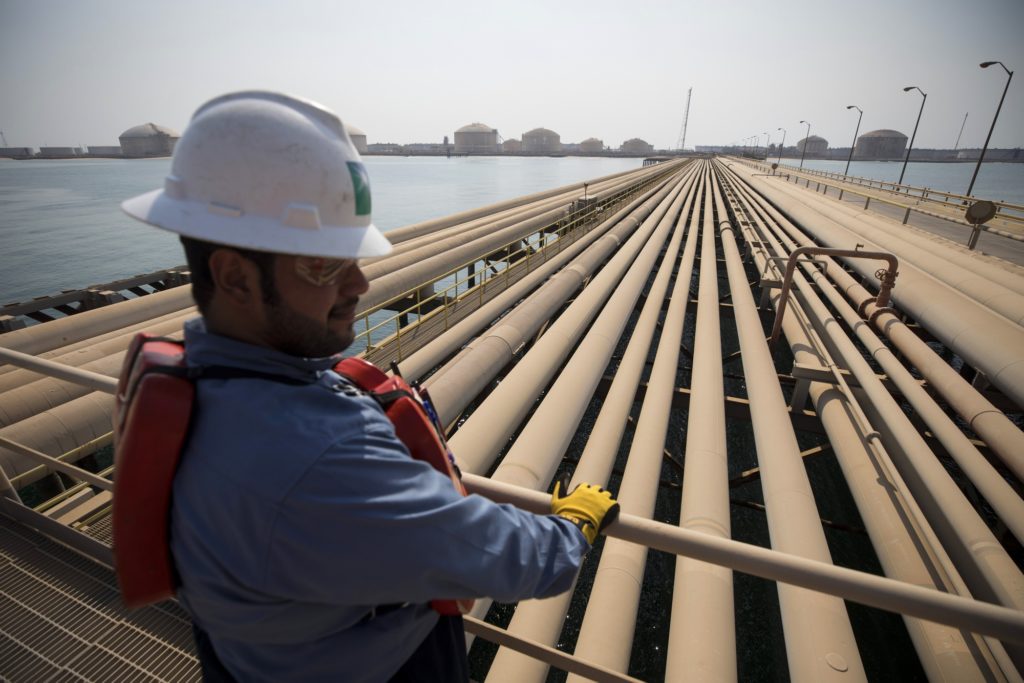
In the wee hours of a sweltering Saturday in September, a volley of missiles and aerial explosives pierced the heart of Saudi Arabia’s oil industry.
The attacks knocked out about 5% of global oil production almost immediately, yet one month later, they might as well never have happened.
Saudi Aramco says it’s currently pumping 9.9 million barrels a day, the same as before the September 14 surprise attacks at Abqaiq, the world’s biggest oil-processing facility, and the field at Khurais.
While the attacks laid bare Saudi Arabia’s vulnerability to major disruptions, Brent crude has slid below where it was beforehand, trading Monday at less than $60 a barrel.
Shiny, freshly painted spherical tanks that separate oil from natural gas and water are back at work at Abqaiq, company officials told reporters touring the damaged sites on Saturday.
On an earlier visit to Abqaiq one week after the assaults, gaping holes showed where projectiles had punctured the same tanks. More repairs await; several crude stabilization towers are still charred and encased in scaffolding.
“It was very important for the Saudis to restore their position as the world’s reliable supplier,” said Richard Mallinson, an analyst at consultant Energy Aspects Ltd. in London.
“The Saudis launched a very active effort to get things back on line and a very big push to maintain their normal supply to markets.”
| How Aramco coped with the oil industry’s worst attacks ever |
|---|
|
The energy industry’s worst-ever attacks inflamed tensions in the Persian Gulf after a summer of oil tanker and pipeline bombings.
The U.S. and Saudi Arabia blamed Iran, while Yemen’s Houthi rebels claimed responsibility.
The strikes threatened Saudi Arabia’s most valuable industry just months before a planned share sale of Aramco, the state oil giant.
Regional stress rose another notch on Oct. 11, when an Iranian tanker came under attack in the Red Sea off the Saudi coast. No one has claimed responsibility yet.
Aramco halted 5.7 million barrels a day of crude output immediately after the assaults on Abqaiq and Khurais, making it the biggest single disruption to global supply.
Facilities at both sites have resumed processing at near full capacity, company officials said on Oct. 12.
Even so, Aramco says it needs more time to make them fully functional, and it doesn’t expect the kingdom to return to its full production capacity of 12 million barrels a day until the end of November.
The attacks exposed within minutes an alarming fragility in OPEC‘s largest producer. And as Aramco rushes its damaged plants back into operation, questions remain about how it was able to restore production so quickly — and whether the recovery is sustainable.
Among the unknowns is whether the processing units were able to remove all the impurities from their crude and whether Aramco might have pumped some oil and then stored it to be treated later, Mallinson said.
Saudi Arabia was already pumping below capacity as the Organization of Petroleum Exporting Countries limits production to counter a global glut.
Expectations for ample supply next year are keeping a lid on prices, said Olivier Jacob, managing director at Zug, Switzerland-based consultant Petromatrix GmbH.
The International Energy Agency trimmed its oil-use forecasts again last week, cutting its estimate for demand in 2019 and 2020 by about 100,000 barrels a day.
While Brent crude jumped the most for nearly three decades in trading on Sept. 16, the benchmark settled at $60.51 a barrel on Friday, only 29 cents more than the close on Sept. 13. Brent dropped further on Monday to as low as $59.67.
“The market is feeling very relaxed about the supply risk,” Jakob said, “But it hasn’t gone away.”
Since the perpetrators of last month’s air strikes faced no consequences, the lack of an armed response could increase the likelihood of attacks in the future, Mallinson said.
“It’s fair to say there was a very rapid recovery,” he said. “It’s a stretch to say that means there should be no market impact.”
Recommended for you
